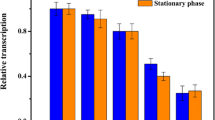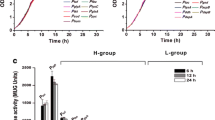Abstract
A pNS-cat72 vector was constructed based on the replicative vector pNS2 and reporter gene cat of Tn9 transposone, which encodes chloramphenicol acetyltransferase, in order to clone various gene promoters and to assess their chloramphenicol resistance in Corynebacterium glutamicum strains. The strength of promoters of various genes in the Corynebacterium glutamicum strain GEN1-2 (lys CA279T, S317A), which contains aspartokinase (which is resistant to lysine) and threonine feedback inhibition were studied using this vector. It was found that promoters of the genes eftu, sod, cspB and leuC provide higher level of chloramphenicol resistance than promoters of the genes lysC, pyc, tkt, fbp, which are involved in the control of lysine biosynthesis. It was shown that replacement of the natural promotor ddh by the promotor sod increases the level of transcription almost by ten times, whereas the diaminopimelate dehydrogenase activity is increases by three to four times, which results in a 9% enhancement in lysine production. The investigated set of promoters with different strengths is a necessary tool for the optimization of gene activities and the construction of metabolite-producing strains.
Similar content being viewed by others

Abbreviations
- DAPD:
-
diaminopimelate dehydrogenase
- CM:
-
culture medium
- OD:
-
optical density
- PCR:
-
polymerase chain reaction
- LB medium:
-
Luria-Bertani medium
- kb:
-
kilobase
- NADPH:
-
reduced form of nicotinamide adenine dinucleotide phosphate
References
Heider, S.A.E. and Wendisch, V.F., Engineering microbial cell factories: metabolic engineering of Corynebacterium glutamicum with a focus on non-natural products, J. Biotechnol., 2015, vol. 10, pp. 1170–1184.
Patek, M., Nesvera, J., Guyonvarch, A., Reyes, O., and Leblon, G., Promoters of Corynebacterium glutamicum, J. Biotechnol., 2003, vol. 104, pp. 311–323.
Becker, J., Klopprogge, C., Zelder, O., Heinzle, E., and Wittmann, C., Amplified expression of fructose 1,6-bisphosphatase in Corynebacterium glutamicum increases in vitro flux through the pentose phosphate pathway and lysine production on different carbon sources, Appl. Environ. Microbiol., 2005, vol. 71, no. 12, pp. 8587–8596.
Tateno, T., Fukuda, H., and Kondo, A., Direct production of L-lysine from raw corn starch by Corynebacterium glutamicum secreting Streptococcus bovis 0- amylase using cspB promoter and signal sequence, Appl. Microbiol. Biotechnol., 2007, vol. 77, pp. 533–541.
Becker, J., Zelder, O., Hafner, S., Schroderand, H., and Wittman, C., From zero to hero—design-based systems metabolic engineering of Corynebacterium glutamicum for L-lysine production, Metabolic Eng., 2011, vol. 13, pp. 159–168.
Schrumpf, B., Eggeling, L., and Sahm, H., Isolation and prominent characteristics of an L-lysine hyperproducing strain of Corynebacterium glutamicum, Appl. Microbiol. Biotechnol., 1992, vol. 37, pp. 566–571.
Construction of shuttle vector for coryneform bacteria and E. coli. Cloning and expression study of lysC gene Rostova, Yu.G., Peredel’chuk, M.Yu., Okorokov, A.L., Gusftiner, M.M., and Debabov, V.G., Biotekhnologiya, 1993, no. 4, pp. 14–17.
Maniatis, T., Fritsch, E. F., and Sambrook, J., Molecular Cloning, Cold Spring Harbor, New York: Cold Spring Harbor Lab. Press, 1982.
Sidoruk, K.V., Levitin, E.I., and Piksasova, O.V., Universal method for isolating high-molecular-weight DNA from microorganisms based on biomass pretreatment with ammonium acetate solution, in Aktual’nye voprosy genetiki, radiobiologii i radioekologii: Vtorye chteniya, posvyashchennye pamyati V.I. Korogodina i V.A. Shevchenko: Tez. dokl. (Abstr. Second Readings in Memory of V.I. Korogodin and V.A. Shevchenko “Topical Issues of Genetics, Radiobiology, and Radioecology”), Dubna: OIYaI, 2008, p. 100.
Van der Rest, M.E., Lange, C., and Molenaar, D., A heat shock following electroporation induces highly efficient transformation of Corynebacterium glutamicum with xenogeneic plasmid DNA, Appl. Microbiol. Biotechnol., vol. 52, no. 4, pp. 541–545.
Cremer, J., Treptow, C., Eggeling, L., and Sahm, H., Regulation of enzymes of lysine biosynthesis in Corynebacterium glutamicum, J. Gen. Microbiol., 1988, vol. 134, pp. 3221–3229.
Merkamm, M. and Guyonvarch, J., Superoxide dismutase in cellular viability of Corynebacterium melassecola and role of cellular viability, J. Bacteriol., 2001, vol. 183, no. 4, p. 1284.
Author information
Authors and Affiliations
Corresponding author
Additional information
Original Russian Text © M.G. Tarutina, N.M. Raevskaya, T.E. Shustikova, L.E. Ryabchenko, A.S. Yanenko, 2015, published in Biotekhnologiya, 2015, No. 6, pp. 16–24.
Rights and permissions
About this article
Cite this article
Tarutina, M.G., Raevskaya, N.M., Shustikova, T.E. et al. Assessment of effectiveness of Corynebacterium glutamicum promoters and their application for the enhancement of gene activity in lysine-producing bacteria. Appl Biochem Microbiol 52, 692–698 (2016). https://doi.org/10.1134/S0003683816070073
Received:
Published:
Issue Date:
DOI: https://doi.org/10.1134/S0003683816070073



